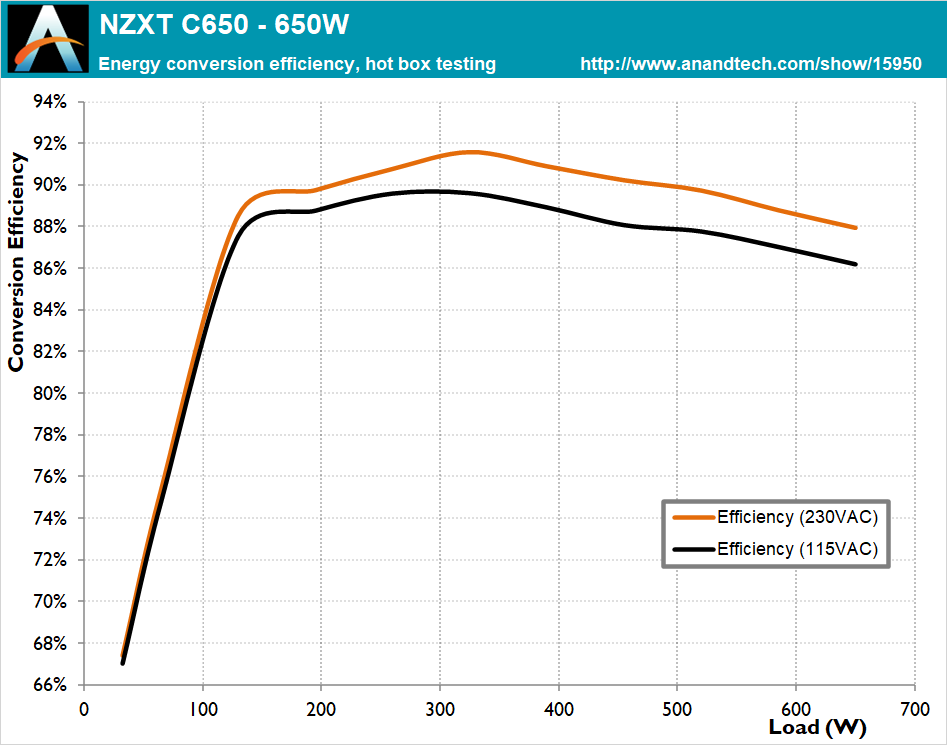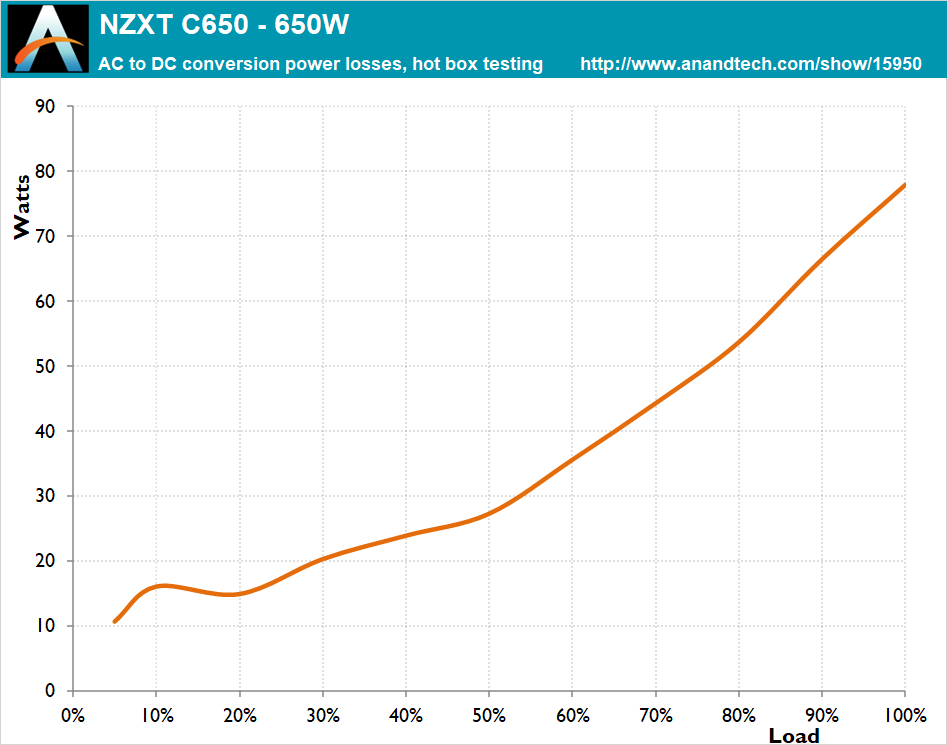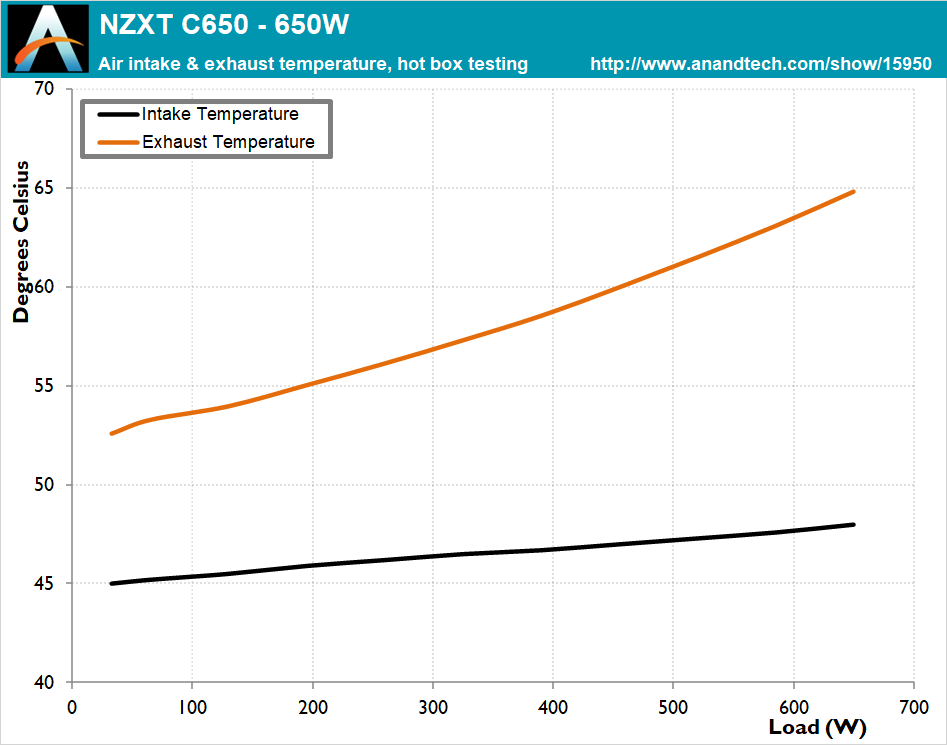The NZXT C650 650W PSU Review: Designed To Last
by E. Fylladitakis on August 11, 2020 8:00 AM EST- Posted in
- Cases/Cooling/PSUs
- PSUs
- 80Plus Gold
- NZXT
- 650W
- Modular
Hot Test Results
As we can see in the following tables, the NZXT C650 delivers great power quality. The maximum voltage ripple on the 12V line is 28 mV, an unimpressive figure nowadays, but less than a quarter of the ATX design guide's recommended 120 mV limit. Ripple on the secondary 3.3V/5V lines is considerably worse, reaching 28 mV on the 5V line with a recommended maximum at 50 mV. We can notice the same pattern on voltage regulation, with the 12V line very tightly regulated at 0.7% and the regulation on the secondary 3.3V/5V lines reaching slightly over 2%.
| Main Output | ||||||||
| Load (Watts) | 130.6 W | 326.19 W | 486.33 W | 647.57 W | ||||
| Load (Percent) | 20.09% | 50.18% | 74.82% | 99.63% | ||||
| Amperes | Volts | Amperes | Volts | Amperes | Volts | Amperes | Volts | |
| 3.3 V | 1.78 | 3.33 | 4.45 | 3.33 | 6.67 | 3.29 | 8.89 | 3.27 |
| 5 V | 1.78 | 5.05 | 4.45 | 5.01 | 6.67 | 5 | 8.89 | 4.97 |
| 12 V | 9.6 | 12.05 | 24.01 | 12.04 | 36.01 | 11.97 | 48.02 | 11.96 |
| Line | Regulation (20% to 100% load) |
Voltage Ripple (mV) | |||||
| 20% Load | 50% Load | 75% Load | 100% Load | CL1 12V |
CL2 3.3V + 5V |
||
| 3.3V | 2% | 10 | 16 | 20 | 22 | 12 | 24 |
| 5V | 1.6% | 12 | 16 | 22 | 28 | 14 | 24 |
| 12V | 0.7% | 16 | 20 | 22 | 28 | 30 | 20 |
Operation in high ambient temperatures does not affect the performance of the NZXT C650 considerably, regardless of the load. The average nominal load range (20%-100%) efficiency drops by 0.8% regardless of the input voltage, going down to an average of 89.8% (230 VAC) / 88.1% (115 VAC). There is very little change across the entire load range, suggesting that the components of the PSU are practically unaffected by the high ambient temperature. The component temperatures are high but not overly so.
As expected, the thermal control circuitry of the NZXT C650 correctly detects the high ambient temperature inside our hotbox and adjusts the fan’s speed accordingly. The NZXT C650 is not silent under these operating conditions, with the fan’s speed gradually increasing along with the load. Nevertheless, the sound pressure level tops out at just 50.2 dB(A), a figure significantly lower than what we would expect from a unit with a powerful 120 mm fan.















34 Comments
View All Comments
Threska - Monday, August 31, 2020 - link
I could see someone going with a shorter ATX power connector. Especially since in my case it really is a short distance and most cables are really long.plonk420 - Tuesday, August 11, 2020 - link
less clutter in your case if you don't have very many components. my daily driver is a 2400G + m.2 ...and 3 SATA devicesLord of the Bored - Wednesday, August 12, 2020 - link
That doesn't explain why you'd want to remove the main ATX power connector.I grant that there ARE some situations where you don't want the motherboard power connector, but they are very rare and the people that need them are used to "manually reconfiguring" the power supply already.
GreenReaper - Wednesday, August 12, 2020 - link
You may, however, wish to replace it if the cable has been frayed somehow, or a connector broke.Might not happen for most people, but you'll be (relatively) glad if it does for you.
Arbie - Tuesday, August 11, 2020 - link
Very important info missing from your cables chart is their lengths. At least, this becomes very important if one neglects to check it...Stele - Wednesday, August 12, 2020 - link
"A trained eye will easily identify the OEM behind the NZXT C650 to be Seasonic" Ya know, it does expressly say right on the PSU label that Seasonic is the OEM...MrVibrato - Wednesday, August 12, 2020 - link
That's what makes a trained eye: To know where to look (:NeatOman - Wednesday, August 12, 2020 - link
Would have liked to see ripple measurements and at different loadsjonnyGURU - Friday, August 14, 2020 - link
Hey guys! This PSU is designed to last while all other PSUs are not!!!! What kind of bullshit marketing is that?Alien88 - Sunday, August 16, 2020 - link
Why are there almost no regular power supplies below 500W or so nowadays? A typical home PC build using an APU and SSD is never going to draw more than around 150W, yet unless you buy a flex ATX or similar PS, you are stuck using a massively overpowered PS that will have shit efficiency at typical operating powers of a regular PC. It seems that virtually all ATX PSs are aimed at the gaming market. For those who neither want nor need a separate GPU, there are very few viable choices. The sad thing is, most people buy a PC with a ridiculously overpowered graphics card simply because they might need it one day, or they simply don't know any better and think they actually need one. Vega graphics has proven that to be untrue (I have a 2400GE and yet do DTP and other graphical design and editing stuff for magazines etc without issue). Imagine how much energy is being wasted globally because of poor hardware choices and a lack of options from manufacturers.